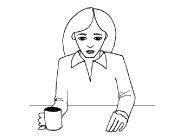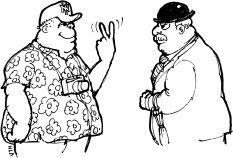The Definitive Book of Body Language (17 page)
Read The Definitive Book of Body Language Online
Authors: Barbara Pease,Allan Pease

Prince Charles's Cuff-Link-Adjust: revealing his insecurities
You would think that after more than half a century of being scrutinized in public and being confronted by large crowds, royals, such as Prince Charles, would be resistant to nervous feelings, but his small arm-crossing behaviors reveal that he feels just as insecure as you or I would feel in the same circumstances.
An anxious or self-conscious man will also be seen adjusting the band on his watch, checking the contents of his wallet, clasping or rubbing his hands together, playing with a button on his cuff, or using any gesture that lets his arms cross in front of his body. A favorite of insecure businessmen is walking into a business meeting holding a briefcase or folder in front of the body. To the trained observer, these gestures are a giveaway because they achieve no real purpose except as an attempt to disguise nervousness. A good place to observe these gestures is anywhere that people walk past a group of onlookers, such as a man who crosses the dance floor to ask a woman to dance or someone who crosses a stage to receive an award.
Women's use of disguised arm barriers is less noticeable than men's because women can grasp on to things like handbags or purses if they become self-conscious or unsure of themselves. Royals like Princess Anne regularly clutch a bunch of flowers when walking in public and the Flowers-Handbag-Clutch is Queen Elizabeth's favorite. It's unlikely that she would be carrying lipstick, makeup, credit cards, and theater tickets in her handbag. Instead, she uses it as a type of security blanket when necessary and as a means of sending messages; royal watchers have recorded twelve signals she sends to her minders about when she wants to go, stop, leave, or be rescued from someone who is boring her.

Handbag used to form a barrier
One of the most common versions of creating a subtle barrier is to hold a glass or cup with two hands. You need only one hand to hold a glass, but two hands allow the insecure person to form an almost unnoticeable arm barrier. These types of gestures are used by almost everyone and few of us are aware that we're doing them.

Flower-grasping shows self-consciousness
Offering a refreshment during a negotiation is an excellent strategy for gauging how the other person is receiving your offer. Where a person places their cup immediately after they take a drink is a strong indicator of whether or not they are convinced or open to what you are saying. Someone who is feeling hesitant, unsure, or negative about what they are hearing will place their cup to the opposite side of their body to form a single-arm barrier. When they are accepting of what they are hearing, they place the cup to the side of their body, showing an open or accepting attitude.

The arm barrier says no

She's now open to your ideas
Sitting with your elbows on the armrest of a chair is a position of power and conveys a strong, upright image. Humble, defeated individuals let the arms drop inside the arms of the chair, so avoid this at all times unless your goal is to appear defeated.
Touching a person with your left hand while shaking hands with your right hand can create a powerful result.
Researchers at the University of Minnesota conducted an experiment that became known as “The Phone Booth Test.” They placed a coin on the ledge of a telephone booth, then hid behind a tree and waited for an unsuspecting subject to walk in and find it. When this happened, one of the researchers would approach the subject and say, “Did you happen to see my coin in that phone booth? I need it to make another call.” Only 23 percent of the subjects admitted they had found it and gave it back.
In the second part of the study, the coin was again placed in the phone booth, but when the researchers approached the people who took it, they touched them lightly on the elbow for not longer than three seconds and inquired about the coin. This time, 68 percent admitted to having the coin, looked embarrassed and said things like, “I was looking around to try to see who owned it…”
Skillful elbow-touching can give you up to three
times the chance of getting what you want.
There are three reasons this technique works: first, the elbow is considered a public space and is far away from intimate parts of the body; second, touching a stranger is not considered acceptable in most countries so it creates an impression; and third, a light, three-second elbow touch creates a momentary bond
between two people. When we replicated this experiment for a television program, we found the coin return rate varied from culture to culture depending on what the normal touch frequency was in a particular place. For example, with elbow-touching, the coin was returned by 72 percent of Australians, 70 percent of English, 85 percent of Germans, 50 percent of French, and 22 percent of Italians. This result shows how the elbow touch works better in places where frequent touching is
not
the cultural norm. We have recorded the touch frequencies between people in outdoor cafés in many of the countries we regularly visit and noted 220 touches an hour in Rome, 142 per hour in Paris, 25 touches an hour in Sydney, 4 per hour in New York, and 0 per hour in London. This confirms that the more British or German your heritage, the less likely you are to touch others and, therefore, the more successful an elbow touch will be on you.
If you're of German or British origin,
you're an easier touch than everyone else.
Overall, we found that women were four times more likely to touch another woman than was a man to touch another man. In many places, touching a stranger
above
or
below
the elbow did not produce the same positive results as with directly touching the elbow and often received negative reactions. Touching for more than three seconds also received a negative response, with the person suddenly looking down at your hand to see what you are doing.
Another study involved librarians who, as they issued a book to a borrower, lightly brushed the hand of the person borrowing the book. Outside the library, the borrowers were surveyed and asked questions about their impressions of the service the
library offered. Those who had been touched responded more favorably to all questions asked and were more likely to recall the name of the librarian. Studies conducted in British supermarkets where customers are lightly touched on the hand when they received their change show similar positive customer reactions. The same experiment has also been conducted in the U.S.A. with waitresses who derive much of their income from customer tips. The elbow-and-hand-touching waitresses made 36 percent more tips from male diners than nontouching waitresses and male waiters increased their earnings by 22 percent regardless of which sex they touched.
When you next meet someone new and you shake hands, extend your left arm, give a light touch on their elbow or hand as you shake, repeat their name to confirm you heard it correctly, and watch their reaction. Not only does it make that person feel important, it lets you remember their name through repetition.
Elbow- and hand-touching—when done discreetly—grabs attention, reinforces a comment, underlines a concept, increases your influence over others, makes you more memorable, and creates positive impressions on everyone.
It makes no difference how you look at it, any crossing of the arms in front of the body is seen as negative and the message is as much in the mind of the receiver as the sender. Even if you fold your arms because, for example, you have a backache, an observer will still unconsciously perceive you as closed to their ideas. Make a decision now to practice
not
crossing your arms and in the following chapters we will show you what to do to project a more positive, confident image.
CULTURAL DIFFERENCES

How would a Brit, a German, or an American interpret this gesture?
Imagine this scene—you are inspecting a house with the possibility of purchasing it and you open a bathroom door to see a woman sitting naked in a bathtub. How would you expect the surprised woman to react? A British or American woman would cover her breasts with one hand and her genitals with the other, while a Swedish woman would cover only her genitals. A Muslim woman would cover her face; a Sumatran woman would cover her knees; and a Samoan, only her navel.
As we are writing this chapter, we are in Venice, Italy, speaking at a conference on cultural differences. If we had never traveled to Italy, we would have been shocked by what we'd experienced. All cultures walk on the same side of the pavement as they drive on the road. This means if you're British, Australian, South African, or a New Zealander, you drive and walk to the left. The consequence is that you'd find the Italians constantly bumping into you as you walk on the pavement because, as they
approach and you step to your left, they step to their right. Wearing sunglasses in foreign countries is the single biggest cause of pavement collisions between cultures because no one can see the other person's gaze to know which way they intend to step. But it's a novel way of meeting new and interesting foreigners.